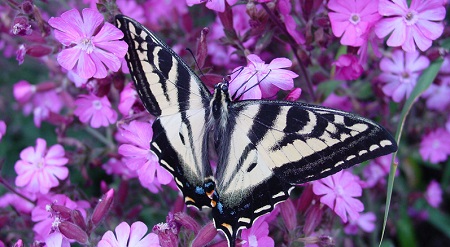BUTTERFLY
 It’s no secret that butterflies are attracted to flowers like people are attracted to… well… butterflies. Well not really! Saying that is like saying you want to eat a butterfly, which is absurd unless you have a little boy around the age of five. People do like butterflies though, and butterflies do like flowers. By planting some of these flowers that butterflies like so much in your own yard, you can create your very own butterfly garden, where you can enjoy butterflies year round. Creating a butterfly garden is a fantastic way to observe wildlife and stay connected with nature. These brilliantly colored creatures are amazing to see, each species with their own distinct shapes and markings. Also, since different species of butterflies are attracted to different flowers, butterfly gardens are often filled with a variety of vibrant color. With just a few simple guidelines, you will be well on your way to discovering the splendor of having your very own butterfly garden. Learning about butterflies, the plants they like, and how to maintain a butterfly garden will insure that you have success no matter what size your project. When working in your Florida butterfly garden wear bright colors, even try wearing a bright colored bandana. By dressing so fashion forward you will be attracting butterflies yourself and making new friends.
It’s no secret that butterflies are attracted to flowers like people are attracted to… well… butterflies. Well not really! Saying that is like saying you want to eat a butterfly, which is absurd unless you have a little boy around the age of five. People do like butterflies though, and butterflies do like flowers. By planting some of these flowers that butterflies like so much in your own yard, you can create your very own butterfly garden, where you can enjoy butterflies year round. Creating a butterfly garden is a fantastic way to observe wildlife and stay connected with nature. These brilliantly colored creatures are amazing to see, each species with their own distinct shapes and markings. Also, since different species of butterflies are attracted to different flowers, butterfly gardens are often filled with a variety of vibrant color. With just a few simple guidelines, you will be well on your way to discovering the splendor of having your very own butterfly garden. Learning about butterflies, the plants they like, and how to maintain a butterfly garden will insure that you have success no matter what size your project. When working in your Florida butterfly garden wear bright colors, even try wearing a bright colored bandana. By dressing so fashion forward you will be attracting butterflies yourself and making new friends.
Okay! Brace yourself for what I’m about to reveal. Butterflies are in fact cold-blooded insects. I said it! The cat has exited the bag! This is an important fact to know however because it explains why butterflies act the way they do. Like lizards, butterflies can sometimes be seen sunning themselves on rocks. This is because in order for a butterfly to take to the skies, it must use the Sun’s rays to keep its blood warm. That’s also why butterflies become more active during the summer. Butterflies are most commonly seen feeding on the nectar of flowering plants. This also aids them in flying. A butterfly’s body processes sugar from the nectar, giving the butterfly the energy it needs to stay aloft.
A butterfly’s wings are very delicate and must stay dry in order to fly. This impedes them from being able to access water sources such as rivers and lakes. Butterflies can be seen drinking from puddles of water that accumulate in tiny impressions in the soil. This behavior is aptly named puddling. To provide a water source that does not dry up quicly, place a natural stone in your bird bath so that the birds can splash water onto it and the your butterflies can utilize the source.
Since butterflies are so frail, they prefer areas sheltered from the wind. You can achieve this in your butterfly garden with proper planting. Tall grasses and shrubs may provide adequate protection. Allow one of your Florida Fire Bush plants to grow to the size of a tree, this will provide further protection from the wind and a place for roosting.
While butterflies feed on the nectar of flowering plants, various species of butterflies feed on different types of plants. Spend some time prior to starting your butterfly garden observing the butterflies in your neighborhood, and the plants they are attracted to. Try planting those types of plants in your yard. This will give you a great start, but if you want to attract new types of butterflies you’ll need to vary your plantings.
An effective butterfly garden should include a variety of plants. Plants are important not just for the feeding of butterflies but also to caterpillars. If you’d like to keep butterflies in your butterfly garden year around, it is a good idea to include some host plants for them to lay their eggs on. These host plants provide shelter and nourishment for hatching caterpillars. While these plants are different from those that butterflies feed on, host plants and nectar plants should be planted close together in your butterfly garden, as butterflies prefer to lay eggs close to the flowers their young will one day feed on. The types of plants you choose to place in your butterfly garden will depend on the types of butterflies you wish to attract.
Once you’ve chosen the correct placement and planting for your butterfly garden, maintaining it should remain fairly hands off. Over time, host plants may begin to look chewed up and can be replaced during butterfly season. Remember that butterflies are insects and spraying your yard with insecticides and other chemicals will kill them. Stop any chemical treatments that may be hindering your butterfly garden. It may take several weeks before you see any butterflies, but give it time and you should see them return. When you stop using harmful chemicals in your garden you may also notice an increase in bee populations and an increase in your vegetable production. With limited pollinators present many gardens do not experience their full production potential.
If after some time you still don’t see any butterflies or would just like to see more, there are alternative methods of luring them to your garden, such as sugaring, butterfly feeders, and butterfly houses. There are endless recipes for sugaring but most involve some combination of sugar and rotten fruit, stale beer, or anything else that will ferment to create a strong sweet smell. Part of the fun might be creating your own recipe. Another choice is to buy nectar, which can be used to fill butterfly feeders and entice other butterflies to visit your garden. These are options yet tend to be troublesome, with the proper plantings and ceasing of chemical kills, you will experience an abundance of butterflies without all of the fuss.
Butterfly houses have thin slits which allow butterflies access, providing a shelter and keeping other animals out. They are easy to install and can be used in any butterfly garden. Ensure that you have trees for roosting such as citrus or Fire Bush. Trees with larger leafs to protect your butterflies from the rain work best. Make a mental note of where your butterflies roost and make efforts to avoid disturbing them during a rain or at night.
At LALA, we have had pleasure of designing numerous successful butterfly gardens that bring the butterflies back again and again. We enjoy the emails from clients, who report when a species of butterfly arrives that they’ve never seen before, or when the caterpillar they’ve watched emerges from its chrysalis, dries its wings, and takes flight for the first time as a beautiful butterfly. For those who would like to enjoy their own butterfly gardens, but don’t have a green thumb, LALA offers solutions.
Thinking about having LALA draw up plans for your next residential or commercial project? We would be glad to incorporate butterfly gardens into any of our custom landscape designs. Just ask. LALA can provide fully signed and sealed construction documents, accompanied with plant lists, cost estimates, and everything else you need to “get your garden on”.
LALA is offering something new! Coming soon, clients that want to have the experience of their own butterfly garden, but don’t necessarily need a custom butterfly garden, will have the option to purchase plans for pre-designed, original butterfly gardens from Land Art Landscape Architecture. While we’ve never done this before, we see this as a chance for us to improve upon the big landscape and bring professional design to a larger audience. New butterfly gardens are being created, so look for updates soon!
To inquire about purchasing a custom butterfly garden design by Land Art Landscape Architecture Contact Us
 Once you start your butterfly garden you will be in awe with the new residents in your garden. Start with your framework tride and true feeders and then expand by adding the specie specific plants to attract your favorites.
Once you start your butterfly garden you will be in awe with the new residents in your garden. Start with your framework tride and true feeders and then expand by adding the specie specific plants to attract your favorites.
 Once you start your butterfly garden you will be in awe with the new residents in your garden. Start with your framework tride and true feeders and then expand by adding the specie specific plants to attract your favorites.
Once you start your butterfly garden you will be in awe with the new residents in your garden. Start with your framework tride and true feeders and then expand by adding the specie specific plants to attract your favorites.
|
FIRE BUSH
Hamelia patens
|
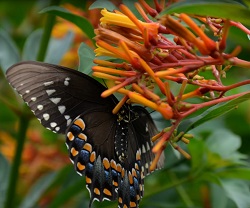
|
 It's a wonder this Florida native hasn't been introduced into landscaping much earlier. Able to withstand amost any condition, it grows in wet or dry soils, sun or shade. Firebush virtually contantly in bloom with narrow red tubular flower, irresistable to butterflies and birds relish the berries. It's new bronzy to red foilage only becomes more intense when grown in the sun. Butterflies are are attracted by the flowers, birds relish the berries. A garden winner.
It's a wonder this Florida native hasn't been introduced into landscaping much earlier. Able to withstand amost any condition, it grows in wet or dry soils, sun or shade. Firebush virtually contantly in bloom with narrow red tubular flower, irresistable to butterflies and birds relish the berries. It's new bronzy to red foilage only becomes more intense when grown in the sun. Butterflies are are attracted by the flowers, birds relish the berries. A garden winner.
|
|
GOLDEN DEWDROPS
Duranta erecta
|
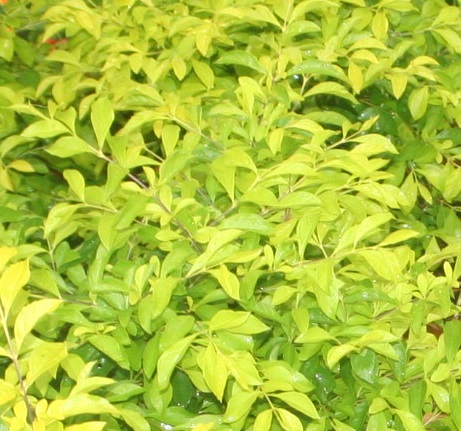
|
 A relatively recent landscape subject, Dewdrops are heading towards becoming a stable in Florida gardens. Ranging in colors of blue, purple and white, this shrub blooms throughout the warm months; during mild years it may bloom all year. The flowers are followed by very attractive orange berries, with both blossoms and the contrasting fruits being carried on the plant at the same time. It can be easily shaped to any form.
A relatively recent landscape subject, Dewdrops are heading towards becoming a stable in Florida gardens. Ranging in colors of blue, purple and white, this shrub blooms throughout the warm months; during mild years it may bloom all year. The flowers are followed by very attractive orange berries, with both blossoms and the contrasting fruits being carried on the plant at the same time. It can be easily shaped to any form.
|
|
PLUMBAGO
Plumbago auriculata
|
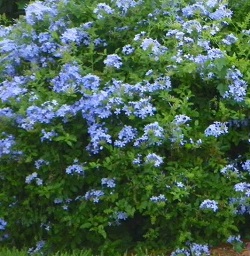
|
 Plumbago is one of the most reliable, care-free shrubs available for our area. The sky-blue flowers are constantly produced in bundles mostly during the warm months, but in a warm, sunny spot they bloom all year long. This landscaping staple doesn't care what kind of soil it is growing in, as long as it isn't swampy. It lends itself to be cut in any shape, whether formal or informal, not affecting this steadfast bloomer one bit. Also available in a white, slightly less vigorous form.
Plumbago is one of the most reliable, care-free shrubs available for our area. The sky-blue flowers are constantly produced in bundles mostly during the warm months, but in a warm, sunny spot they bloom all year long. This landscaping staple doesn't care what kind of soil it is growing in, as long as it isn't swampy. It lends itself to be cut in any shape, whether formal or informal, not affecting this steadfast bloomer one bit. Also available in a white, slightly less vigorous form.
|
|
LANTANA
Lantana montevidensis
|
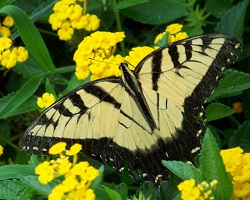 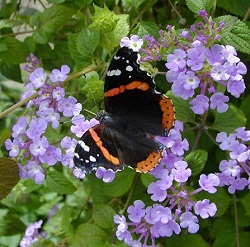 
|
 Trailing Lantana is a must-have for Central Florida landscapes. It's pest-free, drought tolerant characteristics makes them almost beg to be abused. Wherever there is sun, blistering heat and poor soil, Lantana merely chuckles. An uncommon trait among Florida's garden plants; Lantana blooms profusely all year long, just add sun. Available in a spectrum of colors and Butterflies adore them; what more can you ask for?
Trailing Lantana is a must-have for Central Florida landscapes. It's pest-free, drought tolerant characteristics makes them almost beg to be abused. Wherever there is sun, blistering heat and poor soil, Lantana merely chuckles. An uncommon trait among Florida's garden plants; Lantana blooms profusely all year long, just add sun. Available in a spectrum of colors and Butterflies adore them; what more can you ask for?
|
|
PENTAS
Pentas lanceolata
|
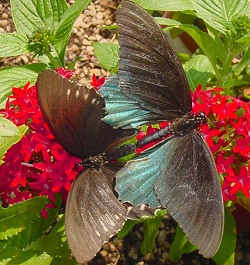
|
 Butterflies come hither. Available in red, purple, white and all shades in between, Butterflies can't resist them. To keep the clusters of blossoms big and plentiful, periodic removal of spent flowers is recommended. They also benefit from a cutting back in spring, after the last danger of frost to keep their size in check. Otherwise there is no care needed for continuous flowers.
Butterflies come hither. Available in red, purple, white and all shades in between, Butterflies can't resist them. To keep the clusters of blossoms big and plentiful, periodic removal of spent flowers is recommended. They also benefit from a cutting back in spring, after the last danger of frost to keep their size in check. Otherwise there is no care needed for continuous flowers.
|
|
RED TEXAS SAGE
Salvia coccinea
|
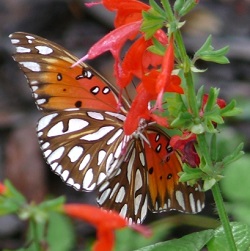
|
 This Salvia doesn't have large blossoms, but the intense red color and the poliferation of the flowers makes it a showy subject when planted in groups or masses. While withstanding all sorts of situations, the plants mirror the conditions; short, compact plants in poor, dry soils, larger lush plants in rich, wet soils. An outstanding trait of this plant is that it reseeds itself readily; the more you grow, the more you will find it popping up everywhere, sometimes in white, peach, and bicolored, but could never be called invasive. Butterflies and Hummingbirds worship these flowers.
This Salvia doesn't have large blossoms, but the intense red color and the poliferation of the flowers makes it a showy subject when planted in groups or masses. While withstanding all sorts of situations, the plants mirror the conditions; short, compact plants in poor, dry soils, larger lush plants in rich, wet soils. An outstanding trait of this plant is that it reseeds itself readily; the more you grow, the more you will find it popping up everywhere, sometimes in white, peach, and bicolored, but could never be called invasive. Butterflies and Hummingbirds worship these flowers.
|
|
BLUE SALVIA
Salvia farfinacea
|
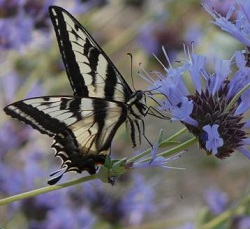
|
 Another Salvia, not native nor self-seeding, but a true perennial when grown in good soil, blessed with a deep, vibrant blue color unmatched by any other flowing garden plant, but available in other colors as well. Blooms until cool weather arrives. Also a Butterfly magnet.
Another Salvia, not native nor self-seeding, but a true perennial when grown in good soil, blessed with a deep, vibrant blue color unmatched by any other flowing garden plant, but available in other colors as well. Blooms until cool weather arrives. Also a Butterfly magnet.
|
MAIN
|
ABOUT
|
PROJECTS
|
POOLS
|
PLANTS
|
OPINION
|
DESIGN
|
VIDEO
|
IDEA GALLERY
|
CONTACT
2005-2019 LAND ART LANDSCAPE ARCHITECTS
Orlando FL Landscape Architect in Central Florida
|


